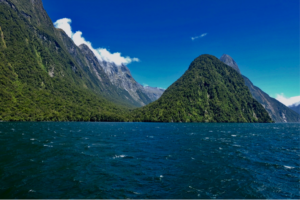Berkley Svingen, the University of Montana’s Sustainability in New Zealand and Australia student blogger, writes:
“We don’t inherit the earth from our ancestors, we borrow it from our children.”
– unknown
Best known for its beloved natural attractions, New Zealand is not a travel destination for those hoping to scurry in and out of art museums or architectural enthusiasts. It is a land for the outdoor adventurer, for those whose souls are most whole under the misty canopy of a grand forest, where purity is found under the frigid waters of a waterfall. Eight out of ten attractions in New Zealand are nature based, and 93% of tourists visit for the natural environment. Standing toe-to-toe with Mother Nature, New Zealand is humbling and a reminder of one’s true size.

Milford Sound
This minimizing effect is apparent when you round the corner and drop into the Milford Sound. Her treasure being encapsulated in landscape makes New Zealand significantly vulnerable to human presence, and the expanding rates of visitation elevates the importance of ecotourism. Threats such as erosion and overcrowding are increasingly presenting challenges for the Department of Conservation (DOC). Such problems are not unique to New Zealand, and are ever so common in various locales around the world. Here are ways you can lessen your impact on the environment while traveling.
1. Understand the tourist industry of your destination
Research the problems facing the area, and act consciously upon arrival. Queenstown, the most popular destination on the South Island, is outgrowing itself. Locals are becoming increasingly concerned with what these rapid rates of expansion mean for the scenic areas surrounding the quaint lake town. Such problems and concerns are not isolated, and should not be placed on the shoulders and pocketbooks of locals who are outnumbered 6-to-1 by tourists. As foreigners, we must not be invasive and should act with self-accountability as we visit this gem of the southern hemisphere to ensure it remains preserved in all its majesty for those to come.
Know the seven principles and religiously practice them. Leave No Trace was originally intended to be applied to outdoor recreation, however, the overarching philosophy can be useful in urban areas as well. Use trash bins even if your waste is biodegradable, leave your accommodations the way you found them (don’t expect your bus driver to throw your smoothie cup away), and don’t feed animals (i.e. squirrels, ducks).

Milford Sound
3. Adopt green living wherever you go
Often you may be left feeling powerless to impact areas not in your immediate surrounding (I know I have). However, understanding you are a member of a global community is the first step to being a contributor. What you do at one place in the world affects those on the other side of the globe. Living a green lifestyle in the United States is a remedy to New Zealand’s problems. Additionally, when wanting to do activities unique to your destination, research tourist companies who are dedicated to sustainable practices so you may prioritize giving your business to them.
4. Support policy
The charming town of Arrowtown on the South Island has restricted expansion. Residents of the community pressured the government to enact legislative laws that do not allow the growth or introduction of any additional industries and infrastructure. Residents cannot add on to their homes or property, the town is the size it will forever be, and all commercial permits are only inherited. This movement is to preserve the community in its current state is a response to overcrowding.
Ramble on,
Berkley






